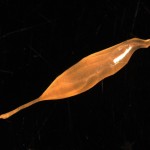Living cells are found everywhere on this planet unless the area is sterile. Run your fingers along a smooth wooden fence (even wood is composed of dead plant cells) and you will pick up cells of pollen, fungal spores, bacteria and probably green algae. Most of the cells will be too small to see without a microscope but you will probably have hundreds of cells on your fingers.
Living cells are also found in hot volcanic vents in the ocean floor and the very cold parts of the planet.
Cut open an orange or grapefruit. Pick out one of the small parts you eat. It will be a little sac tapering to hair like points at the ends. This is a large plant cell.
Some organisms are composed of only one cell. This group includes bacteria that reproduce so quickly that it is unlikely that just one cell will be present and you are more likely to see a group or colony of them.
Another group of single cell organisms including paramecium and amoeba are rather larger and like the amazingly large single cell marine plant acetabularia (Mermaid’s wineglass) live in a wet environment.
The eggs of some animals are single cells but they are generally combined with a large food store, hence their large size. Single cell organisms are a very successful group and account for more than half the total biomass on earth.
Some single celled organisms live in groups forming a loose colony. Some join up to form a more fixed colony. The green algae volvox for example can form a hollow ball colony of 50,000 cells. The cells are connected by fine threads and act as one organism propelling the ball of cells by spinning it in one direction. The cells become dependent upon one another and if the ball is broken up the colony will die.
In multicelled organisms specialised cells performing the same function are organised into groups and are called tissue. Examples from plants include photosynthetic and water conducting tissue. Examples from animals include muscle tissue and brain tissue.
Cells and specific tissues can form a structural and functional unit called an organ. A leaf is an example from the plant kingdom and the stomach and the heart are examples of organs in humans. Organs working together form an organism.
In young animals and plants cells are constantly being produced as the organism grows. Cells are also being produced to replace damaged and worn out cells.
It has been estimated that cells in your stomach lining are replaced every 5 days; the surface cells of your skin every four weeks and your liver every 6 weeks. Animals can grow cells of scar tissue over cuts and burns and when a branch is cut off a tree scar tissue gradually grows from the bark across the wound.
From a biological point of view some cells are quite remarkable in that they can reproduce almost without limit.
Unfortunately cell reproduction in an uncontrolled way can produce tumours. Tumours can grow which are benign or non-invasive but many are malignant and invade normal tissue and damage it. This condition is called cancer.
There are many types of cancer and different forms affect different tissues but the malfunction of cells is the basic cause. In an increasing number of cases the growth and effect of cancerous cells can be held in check. Research in cell biology has made this possible.
SOMETHING TO THINK ABOUT:
Single cell organisms are a very successful group of livings things but they are all small. What problems do you think would arise if large animals and plants were composed of only a single large cell? What are the advantages of being large but multicellular?

